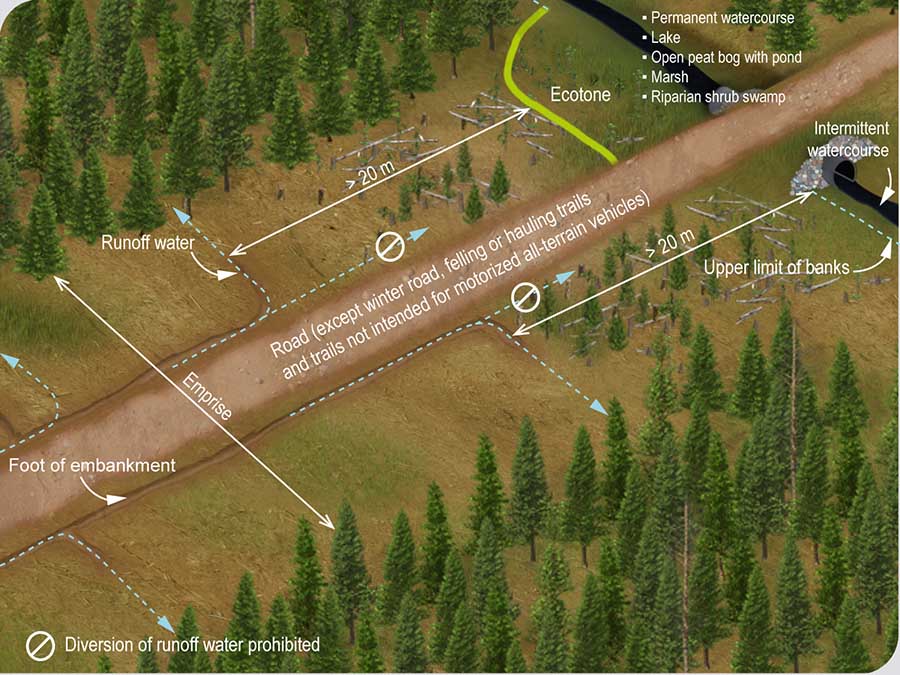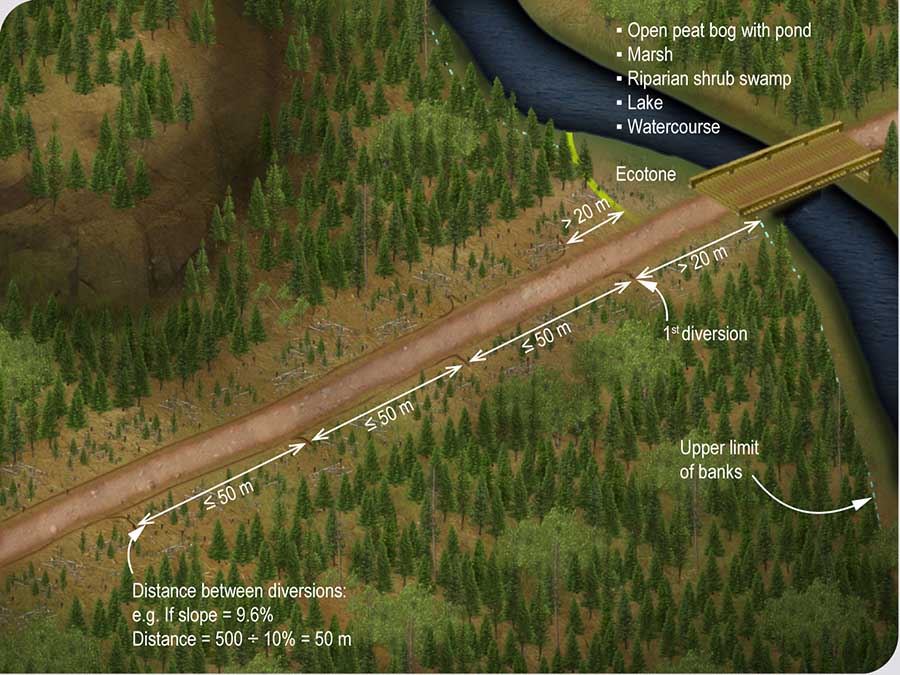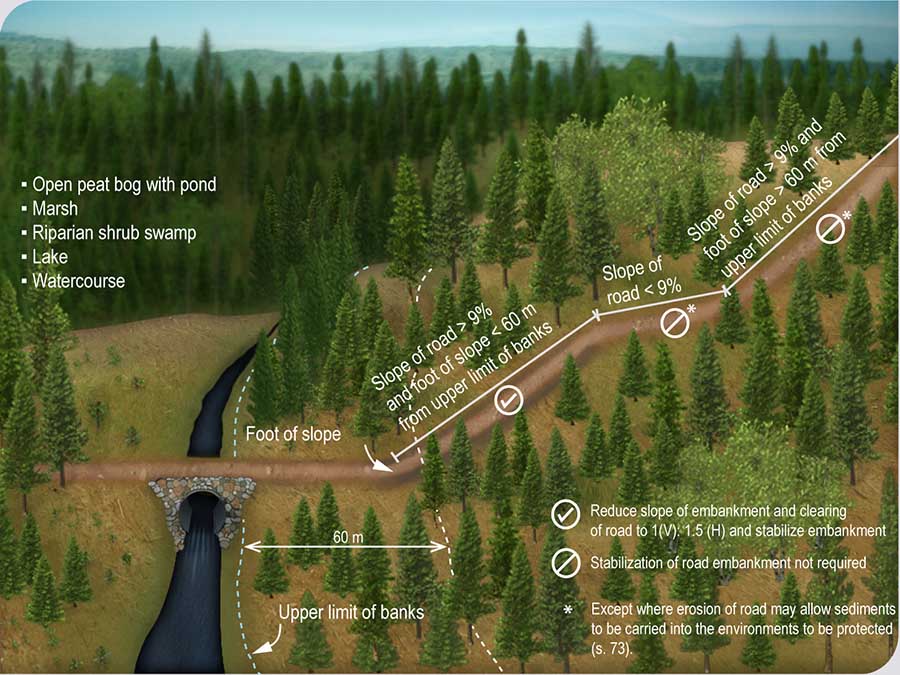Chapter V – Roads, sandpits and forest infrastructures
Division II – Roads
§4. Stabilization of excavated soils and road embankments and diversion of runoff
Section 76
During the construction, improvement, repair or maintenance of a road, the water flowing at the foot of the embankments of a road, other than a felling or hauling trail, other than a trail not intended for motorized all-terrain vehicles or other than a winter road, must be regularly diverted outside the right-of-way of the road towards vegetation areas located more than 20 m from an open peat bog with a pond, a marsh, a riparian swamp, a lake or a watercourse.
The maximum distance in meters to be respected between the diversions is calculated by dividing the number 500 by the percentage, in whole number rounded to the closest unit, of the road slope, or is calculated by any other technique ensuring that the diversions are in a sufficient number and laid out so as to prevent the erosion of the road. 
1
Objectives
- To preserve the integrity of an aquatic, wetland or riparian environment
- To avoid carrying sediment into an aquatic, wetland or riparian environment
- To ensure the lifespan of a road, bridge or culvert
Additional information
The maximum distance in metres to be respected between the diversions is calculated by dividing the number 500 by the percentage of the road slope as a whole number rounded to the closest unit.

For example, if the road slope is 9.6%, the slope percentage as a whole number rounded to the nearest unit is 10. The maximum distance to be respected between the diversions is therefore 50 m, or 500 ÷ 10.
The distance between the diversions may also be calculated using a different technique, to make sure they are sufficient in number and laid out so as to prevent the erosion of the road. While this is not mandatory, we recommend that appropriate techniques be agreed upon with representatives from the regional office of the Ministère des Ressources naturelles et des Forêts  (in French only) before beginning work to divert water flowing at the foot of the embankment of a road.
(in French only) before beginning work to divert water flowing at the foot of the embankment of a road.
In the event that an alternative method is chosen, it must meet the following objectives:
- To preserve the integrity of an aquatic, wetland or riparian environment
- To avoid carrying sediment into an aquatic, wetland or riparian environment
- To ensure the lifespan of a road, bridge or culvert
Figure 76A Diversion of water flowing at the foot of the embankment of a road
Figure 76B Distance between diversions of water flowing at the foot of the embankment of a road
Where the slope of the road to be built or improved is greater than 9% and the foot of the slope is less than 60 m from an open peat bog with a pond, a marsh, a riparian shrub swamp, a lake or a watercourse, the slope of the embankment and the clearing of the road must be reduced to a ratio of at least 1 (V): 1.5 (H) and the embankment must be stabilized using the techniques mentioned in section 73.  This paragraph does not apply to a person who, in accordance with section 41 of the Sustainable Forest Development Act
This paragraph does not apply to a person who, in accordance with section 41 of the Sustainable Forest Development Act  (chapter A-18.1), was authorized by the Minister to build or improve a road meeting other conditions, or to a person who has obtained such an authorization by a forestry permit or a contract or agreement entered into under that Act.
(chapter A-18.1), was authorized by the Minister to build or improve a road meeting other conditions, or to a person who has obtained such an authorization by a forestry permit or a contract or agreement entered into under that Act. 
2
Objectives
- To preserve the integrity of an aquatic, wetland or riparian environment
- To avoid carrying sediment into an aquatic, wetland or riparian environment
- To ensure the lifespan of a road, bridge or culvert
Figure 76C Stabilization of the embankment of a road with a slope greater than 9%
3
Objective
- To protect forest resources during specific road, bridge or culvert construction or improvement work
Explanations
A person authorized by the Minister in accordance with section 41 of the Sustainable Forest Development Act  may build or improve a road on conditions other than those indicated in the third paragraph of this section concerning reduction of the slope of the embankment, the clearing of the road and stabilization of the embankment. The Minister may grant authorization, specifying the authorized replacement standards and setting conditions to be met when carrying out the work.
may build or improve a road on conditions other than those indicated in the third paragraph of this section concerning reduction of the slope of the embankment, the clearing of the road and stabilization of the embankment. The Minister may grant authorization, specifying the authorized replacement standards and setting conditions to be met when carrying out the work.
Additional information
A person wishing to obtain authorization must complete the following steps:
- Fill out the LADTF Section 41 Authorization Application Form
 ;
; - Have it signed by a forest engineer;
- Forward it to the management unit in the region
 (in French only) where the project is located.
(in French only) where the project is located.
The application must describe the situation that justifies completion of the work in accordance with standards different from those enacted in the Regulation. It must also propose replacement measures that will be implemented to achieve the objectives of the regulatory standards from which a departure is requested. Where the proposed replacement standards fall within the approval framework, authorization may be granted along with conditions that must be met when carrying out the work.
In the case of the repair of a road whose slope is greater than 9% and whose foot of the slope is less than 60 m from an open peat bog with a pond, a marsh, a riparian shrub swamp, a lake or a watercourse, the slope of the embankment and the clearing of the road must be stable and not allow the carrying of sediments into the environment to be protected. 
4
Objectives
- To preserve the integrity of an aquatic, wetland or riparian environment
- To avoid carrying sediment into an aquatic, wetland or riparian environment
- To ensure the lifespan of a road, bridge or culvert



